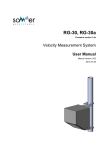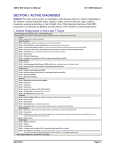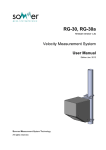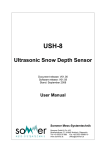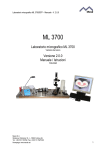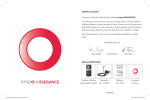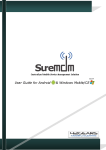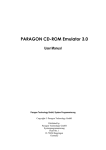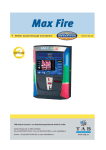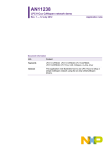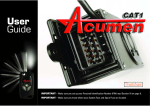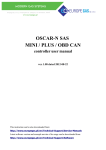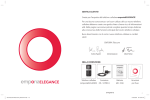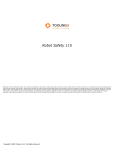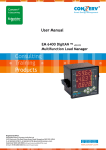Download Manual SPA
Transcript
SPA Snow Pack Analyser Document version: V01.03 Software version: V03.28 Date: November 2010 User Manual Sommer Mess-Systemtechnik Sommer GmbH & Co. KG Strassenhaeuser 27, A-6842 Koblach, Austria Tel +43 5523 55 989 Fax +43 5523 55989 19 www.sommer.at [email protected] User Manual SPA Snow Pack Analyser V01.03, V03.28, November 2010 Table of contents Table of contents ........................................................................................................................................... II 1. General information.................................................................................................................................... 1 1.1. Principle of measurement.................................................................................................................... 1 1.2. Measurement parameters ................................................................................................................... 1 2. Hardware ................................................................................................................................................... 2 2.1. SPA-sensors ....................................................................................................................................... 2 2.2. Correction length sensor ..................................................................................................................... 2 2.3. Snow depth sensor ............................................................................................................................. 2 2.4. Control unit IA-SPA ............................................................................................................................. 2 2.5. Data logger MDL (optional).................................................................................................................. 2 2.6. Installation framework ......................................................................................................................... 2 3. Installation.................................................................................................................................................. 3 3.1. Measurement site................................................................................................................................ 3 3.2. Framework.......................................................................................................................................... 3 3.3. Snow depth sensor ............................................................................................................................. 3 3.4. Sloping SPA-sensor ............................................................................................................................ 4 3.5. Correction length sensor ..................................................................................................................... 4 3.6. Horizontal SPA-sensors ...................................................................................................................... 5 3.7. Housing .............................................................................................................................................. 5 3.8. Power supply ...................................................................................................................................... 5 3.9. Summary ............................................................................................................................................ 5 4. Implementation on Start-up ........................................................................................................................ 6 4.1. Capacitance of SPA-sensor................................................................................................................. 6 4.2. Geometric parameters......................................................................................................................... 6 4.3. Snow depth measurement................................................................................................................... 7 4.4. Length correction of sloping SPA-sensor ............................................................................................. 7 4.5. Measurement interval.......................................................................................................................... 7 4.6. Data output ......................................................................................................................................... 7 4.7. Summary ............................................................................................................................................ 7 5. Parameterization ........................................................................................................................................ 8 5.1. Connection establishment via terminal................................................................................................. 8 5.1.1. Local communication..................................................................................................................... 8 5.1.2. Communication via ComWin.......................................................................................................... 8 5.1.3. Connection affirmation................................................................................................................... 8 5.2. Main Menu .......................................................................................................................................... 9 5.3. Description of the parameters.............................................................................................................. 9 1 Device identifier ................................................................................................................................ 9 2 Meas. Interval ................................................................................................................................... 9 3 Output time....................................................................................................................................... 9 4 RS232 output.................................................................................................................................. 10 5 RS232 settings ............................................................................................................................... 11 6 Analog input.................................................................................................................................... 12 7 SPA parameter ............................................................................................................................... 13 8 Sensor_ .......................................................................................................................................... 14 I Info.................................................................................................................................................. 15 / Total Info ......................................................................................................................................... 15 W Default .......................................................................................................................................... 15 X Exit................................................................................................................................................. 15 6. Data output .............................................................................................................................................. 16 6.1. Protocol values ................................................................................................................................. 16 6.2. Standard protocol.............................................................................................................................. 17 6.3. MIO Protocol ..................................................................................................................................... 17 7. Base settings and default values .............................................................................................................. 18 8. Connection diagram ................................................................................................................................. 19 8.1. Overview........................................................................................................................................... 19 9. Technical data.......................................................................................................................................... 20 - II - User Manual SPA Snow Pack Analyser V01.03, V03.28, November 2010 1. General information Obtaining information about snow by measurements is a difficult task. A multiplicity of parameters have to be registered to make reliable statements about the snow pack. Additionally, snow has an enormous variability in space and time. Up to now mainly punctual measurements are available for the relevant parameters. The Snow Pack Analysing System (SPA) constitutes a revolutionary innovation in snow measurement. It is a world unique system for automatic and continuous measurement of all the relevant snow parameters like snow depth, snow density, snow water equivalent and contents of liquid water and ice. The SPA offers a modern and highly time delayed data gathering. There are several possibilities to install the system, depending on demand. Moreover, the system helps to reduce dangerous and expensive adoption of human resources in the wintry area. 1.1. Principle of measurement Fig. 1: Principle of measurement of the SPA-sensor Snow consists out of the three components ice, water and air. Referring to different measurement frequencies, these components show different dielectric constants. Measuring the complex impedance along a flat ribbon sensor (SPA-sensor) with at least two frequencies allows to estimate the volume contents of the individual components. These specific volume contents equate the liquid water, ice and air content in the snow pack, which consequently results in the snow density. Combining the snow density with the snow depth defines the snow water equivalent. 1.2. Measurement parameters Snow density The SPA calculates the snow density of the snow surrounding the SPA-sensor. Snow water equivalent SWE The SWE corresponds to the water column in mm resulting from the melting of the complete snow cover on a defined area. It is calculated from the snow density of sloping sensors with respect to the snow depth. Contents of liquid water and ice in snow pack The volumetric contents of ice and liquid water in the snow are output in %. Snow depth The snow depth is measured by an ultra sonic sensor. It is necessary to determine the SWE. -1- User Manual SPA Snow Pack Analyser V01.03, V03.28, November 2010 2. Hardware Abb. 1: SPA-senor and IA-SPA control unit 2.1. SPA-sensors The SPA-sensor is a 6 cm wide flat ribbon sensor including three copper wires. The length varies between 3 and 10 m. Its ends are covered by boxes including attachment rings. The connection cable is led out of one box. 2.2. Correction length sensor The deforming of sloping sensors due to the snow pack can be corrected by measuring the additional length of the sensor rope at the suspension. The sensor measures the rotation of the suspension roll and converts the values into length. The correction is automatically included in the calculation. 2.3. Snow depth sensor The snow depth sensor USH-8 is based on transit-time measurements of an ultrasonic pulse between the sensor and the snow surface. It is mounted with an extension arm on a mast and is directly connected to the control unit. 2.4. Control unit IA-SPA The control unit IA-SPA performs all measurements, switches between multiply sensors and calculates the snow parameters with respect to snow depth, length correction and geometric parameters. The data is output via a RS-232 interface. 2.5. Data logger MDL (optional) An optional data logger receives the data values from the IA-SP and stores it in defined intervals. 2.6. Installation framework The framework enables the installation of one sloping and up to three horizontal sensors and secures a tight and upright positioning of the sensors. It includes the basement framework, a mast for the installation of the sloping sensor, the snow depth sensor and the housing and suspension equipment for the SPA sensors consisting of springs, levers and stretching devices. -2- User Manual SPA Snow Pack Analyser V01.03, V03.28, November 2010 3. Installation 3.1. Measurement site A representative measurement site is horizontal and is not located in a basin or on a ridge. It is free of influences from trees or rocks and is not exposed to intensive winds. An undisturbed accumulation of the snow pack has to be guaranteed. 3.2. Framework Fig. 2: SPA framework Fig. 3: Connection construction with foot First the basement framework is placed on the ground. It is delivered separated in two parts each with about two 4 m long steel beams connected with cross-beams. The side with the two round cross-beams is for the installation of the mast and the fixation of the suspension, the side with the rectangle cross-beam is used for fixing the sensors. The inner L-shaped cross-beam can be located at three position, depending on the installation height of the sloping sensor of 1, 1.5 or 2 m. The two parts of the framework are connected with a connection construction consisting of a u-profile, screws and a foot. It is important to install the framework with an initial tension to resist the forces of the spanned sensors. This is achieved by connecting the two parts of the framework in a small angle, support it with the foot and fix it with the screws. The height of the foot should be at least 10 cm. After the installation of the basement the mast is installed on the inner round cross-beam. The mast holds the snow depth sensor, the rolls for the sloping SPA-sensor and the housing for the measurement and communication devices. It is recommended to install the snow depth sensor before erecting the mast. The mast is supported with two steel wires to be spanned to the near edges of the basement. 3.3. Snow depth sensor The snow sensor is an ultra sonic sensors using transit time measurement. It is installed on the top of the mast using the extension arm. The installation height has to be 1 m above the expected maximal snow depth. The extension arm should be orientated on one side of the framework to guarantee a snow measurement free of influences. Ensure that the area of the snow depth measurement is free of constructions, sensors or cables and that it will be undisturbed during the complete winter season. Use barrier tapes to prevent accidental entering of the area. -3- User Manual SPA Snow Pack Analyser V01.03, V03.28, November 2010 3.4. Sloping SPA-sensor Fig. 4: Suspension at the mast Fig. 5: Suspension at top of the spring Fig. 6: Far end of framework The installation height of the sloping SPA-sensor should be higher than the maximal expected snow depth. On the mast are three predrilled positions at heights of about 1, 1.5 and 2 m. Depending on the selected height the L-shaped cross-beam is installed at the predefined positions at the far end of the framework. The higher the sensor is spanned, the nearer the cross-beam is located, where the bottom end of the SPA-sensor is fixed. To span the sensor a spring and pulley system is used, that is spanned by a stretching device. The stretching device is fixed at the near end of the framework and connected to the spring. The small bar with the lower roll of the pulley system is connected to the opposite side of the spring. The rope of the pulley system is fixed at the top screw of the bar connected to the spring. Then it is guided to the inner roll fixed on the mast, back to the roll on the pulley system, up to the outer roll on the mast and through the roll of the sensor. Finally it is connected to the screw located bellow the rolls on the mast. Then the sensor is spanned using the stretching device. 3.5. Correction length sensor If a correction length sensor is used for the sloping sensor, it is installed at the deflector roll located on the mast. The bolt of the sensor has two rotary stop positions. Make sure that the bolt is in the correct position to react to extensions of the suspension rope. -4- User Manual SPA Snow Pack Analyser V01.03, V03.28, November 2010 3.6. Horizontal SPA-sensors Fig. 7: Spring connection for horizontal sensor Fig. 8: Spring connection for lowest sensor The horizontal SPA-sensors are installed at predefined levels on the installation rack. The far end of the sensors are connected to the L-shaped bars at the far end of the framework. Then they are connected to the levers located on the crossbeam of the mast. The stretching devices are fixed to the round cross-beam at the other end of the framework. The springs are positioned directly at the levers and connected to the wires of the stretching devices. Afterwards the sensors are spanned using the stretching devices until the spring has elongated by about 100 mm and the sensor is 5000 mm long. The horizontal sensors are supported with about 5 forks to ensure an upright and stable position. 3.7. Housing Mount the housing on the mast and connect the cables of the SPA-sensors, the snow depth sensor and the correction length sensor at the marked inputs. 3.8. Power supply The supply voltage of the complete system is 10,5 to 15 VDC. 3.9. Summary • • • • • • Install framework with an initial tension. Locate snow depth sensor 1 m above the maximal expected snow depth. Install the sloping SPA-sensor higher than the maximal expected snow depth. Span the sensor using the stretching device. Install correction length sensor and set rotary bolt to correct position. Install and Span horizontal sensors by elongating the spring by about 100 mm. -5- User Manual SPA Snow Pack Analyser V01.03, V03.28, November 2010 4. Implementation on Start-up 4.1. Capacitance of SPA-sensor The capacitance of the SPA-sensor is measured at a low frequency of 10 kHz and a high frequency of 150 kHz. The capacitance of one meter sensor in the air is 16,7 pF at both frequencies and consequently about 84 pF for a 5 m long SPA-sensor. The values may vary with humidity and water on the sensor. 4.2. Geometric parameters The correct calculation of the snow parameters demands the geometric situation of all included sensors. Especially for the sloping SPA-sensor these settings are used to determine the length of the sensor in the snow and to correct a smooth inclination of the measurement site. The geometric parameters are measured with a measuring tape and should be of about 1 cm accuracy. The geometric parameters are entered into the menu of the IA-SP device (see page 14). Abb. 2: Geometric parameter of SPA-sensor The following geometric parameters are necessary: • Sensor length: Length of the sensor from one box to the other. • Roll height: Plumb line height of the top of the roll and the ground • Foot height: Plumb line height of the middle of the sensor at the lower box and the ground • Brace length: Distance between the middle of the roll and the sensor at the upper top box. • Ground length: Distance on the ground between plumb line of roll and plumb line of sensor foot. For horizontal sensors the roll height and the foot height have to be equal. The brace length is set to “0”and the ground length is equal to the sensor length. -6- User Manual SPA Snow Pack Analyser V01.03, V03.28, November 2010 4.3. Snow depth measurement The snow depth is an essential parameter to calculate the snow pack parameters of sloping sensors. On one hand the length of the sensor in snow is determined and on the other hand the total SWE is calculated using the actual snow depth. The snow depth measurement has to be adjusted in the control unit IA-SPA by entering the actual value in the menu “Analog input”and “Snow depth adjustment”(see page 12). A test measurement of the snow depth is performed with the menu item “Snow depth check" (see page 12). 4.4. Length correction of sloping SPA-sensor A sloping SPA-sensor is installed with a spring to ensure a tight spanning and to prevent the sensor from damages due to compression of the snow pack. This non static installation may cause changes in the sensor position, that can be corrected by measuring the extension length of the sensor suspension. In delivery state the distance measurement for SPA-sensor 1 is connected to the analog input 1. This input has to be defined for the SPA-sensor in the menu item “Input length corr.”(see page 14). After the installation of the SPA-system the measurement value is set to “0” using the menu item “Target value adjustment input_01”(see page 12). The actual value is checked with the menu item “Input check”. Horizontal sensors are operated without length correction by setting the value of the “Input length corr.”to “0”. 4.5. Measurement interval The measurement interval defines the range of time when measurements are performed. It is important not to use a to short interval, as measurements are performed with a measurement battery. A to short measurement interval will prevent the battery from charging and the measurement will be invalid. The recommended interval is 10 minutes (= 600 s). 4.6. Data output The data is output via the serial interface in the selected protocol type (see chapter 6), where the measurement values can be checked. Secondly the data values are usually input into a data logger and should be accepted correctly there. At start-up the values of the capacitances are about 16,7 pF per m SPA sensor in air, the snow depth measurement is the actual snow depth and the length correction is about “0”at start-up. 4.7. Summary • • • • • • Check capacitance values of about 16,7 pF per m SPA sensor in air. Measure geometric parameters of all SPA-sensor and enter into IS-SPA. Adjust snow depth sensor. Adjust length correction and set input for sloping SPA-sensors. Set measurement interval to 10 minutes or longer. Check output data values on serial interface and connected data logger. -7- User Manual SPA Snow Pack Analyser V01.03, V03.28, November 2010 5. Parameterization 5.1. Connection establishment via terminal 5.1.1. Local communication The parameterization of the IA-SP can be performed by directly connecting the serial interface with a PC or laptop. Any communication program can be used. An example is the program HyperTerminal, that is included in the standard installation of windows operating systems. It is opened by: Start → Programs → Accessories → Communications → HyperTerminal The connection cable is a serial data cable with a 1:1 connection (not crossed). Fig. 3: Connection of the IA-SP via serial interface To communicate with the sensor in delivery state the following settings are required: Baud rate: Data bits: Parity: Stop bits: Flow control: 9600 8 none 1 none Tab. 1: Parameter settings for serial connection 5.1.2. Communication via ComWin ComWin is a communication and parameterization software for MDL data loggers. Serial sensors connected to the upper interface of the MDL can be accessed and the menus can be opened in a terminal. Ensure that the IA-SPA is connected to the bottom interface of the MDL data logger via the serial interface using an serial cable with a 1:1 connection (not crossed). Connect to the MDL data logger (see ComWin manual) using the Setup mode. The parameterization window for the MDL will open. The communication with a connected serial sensor is performed by the menu “Terminal”and the menu items “Terminal Port B”or “Terminal Port C”. A terminal window will open. The communication parameters of port B and port C are edited using the tab pages “Port B”and “Port C”. 5.1.3. Connection affirmation If a connection is established and the sensor is switched on, a connection affirmation is sent. IA-SPA (c)2006-2009 Sommer GmbH&CoKG Software version : wdV3.28r01 -8- User Manual SPA Snow Pack Analyser V01.03, V03.28, November 2010 5.2. Main Menu The main menu is opened by quickly entering three question marks “???”in the terminal program. ************************************************** IA-SPA Main menu, V3.28r01 ************************************************** 1 Device identifier 2 Meas. Interval 3 Output time 4 RS232 output 5 RS232 settings 6 Analog input 7 SPA parameter 8 Sensor_01 9 Sensor_02 A Sensor_03 B Sensor_04 0 30 s After meas I Info W Default X Exit Fig. 4: Main menu The menu items are accessed by entering the menu key display left of the menu item. Either sub menus are opened or the specific parameter is displayed with the corresponding unit. Changes are verified with “Enter”, editing is aborted with “Esc”. Sub menus are closed with “X”. The menu is not case sensitive. If the main menu is closed, the sensor starts the measurement mode and returns the message “run”. 5.3. Description of the parameters 1 Device identifier The device identifier is included in the output protocol to identify the data values. The fist output string is assigned with the device identifier. For every following string the device identifier is increased by 1 (see chapter 6). It is recommended to set the device identifier to “0”. Value range: 0 to 9999 (default: 0) 2 Meas. Interval The measurement interval controls the time for the measurements. For permanent monitoring it is important, not to set a to short interval. The measurements are performed using a measurement battery. A to short measurement interval will prevent the battery from charging and the measurement will be invalid. The recommended interval is 10 minutes (600 s). Unit: Value range: [s] 5 to 13980 (default: 600) 3 Output time The output of the data is either performed directly after the measurement or the data strings are requested by a exclamation mark sent via the RS-232 interface. Values: • After meas =1 • Per ‘ !’over RS232 = 2 (default) -9- User Manual SPA Snow Pack Analyser V01.03, V03.28, November 2010 4 RS232 output In this submenu the parameter for the output protocol of the RS-232 interface are listed. RS232 output 1 Protocol type 2 Sync-Out 3 Sync-Out hold-back time 4 Send delay X Exit Fig. 5: Submenu: RS232 output MIO extended Blank 3 x1/10 s 10 x1/10 s 1 Protocol type The protocol type for the data output via the RS-232 is selected. For a description of the protocol see chapter 6. Basic protocols do not include the capacitances and phases, only the extended protocols do. Values: • Off =1 • Standard basic =2 • MIO basic =3 • Standard extended = 4 • MIO extended =5 (default) 2 Sync-Out The parameter is used for waking up connected data logger. Either a blank is sent prior to the output strings, or the RTS control line is switched on. Values: • Off • RTS method • Blank =1 =2 =3 (default) 3 Sync-Out hold-back time The holdback-time defines the time span between the Sync-Out signal (blank or RTS) and the transmission of the output string. Unit: Value range: [1/10 s] 3 to 20 (default: 3) 4 Send delay The sending delay defines the time span between the strings of the protocol. Unit: Value range: [1/10 s] 3 to 100 (default: 10) - 10 - User Manual SPA Snow Pack Analyser V01.03, V03.28, November 2010 5 RS232 settings In this submenu the parameters of the RS-232 interface are listed. Changes will cause a reboot of the IS-SP. A new parameterization of the interface at the PC may be necessary too. RS232 settings 1 Baud rate 2 Parity 3 Data bits 4 Stop bits X Exit Fig. 6: Submenu: RS-232 settings 9600 None 8 1 1 Baud rate The baud rate of the RS-232 interface is selected. Values: • 1200 Baud • 2400 Baud • 4800 Baud • 9600 Baud • 19200 Baud = = = = = 1 2 3 4 5 (default) 2 Parity The parity of the RS-232 interface is set. Values: • none • even • odd =1 =2 =3 (default) 3 Data bits The number of data bits for the RS-232 interface is set. Values: • 7 Data bits • 8 Data bits =1 =2 (default) 4 Stop bits The number of stop bits for the RS-232 interface is set. Values: • 1 Stop bit • 2 Stop bits =1 =2 (default) - 11 - User Manual SPA Snow Pack Analyser V01.03, V03.28, November 2010 6 Analog input In this menu the measurement values of the snow depth and the analog inputs can be adjusted. Measurements can be performed and the measurement values are displayed. Analog input 1 Target value adjustment input_01 2 Target value adjustment input_02 3 Target value adjustment input_03 4 Target value adjustment input_04 5 Target value adjustment input_05 6 Input check 7 Snow depth adjustment 8 Snow depth check X Exit Fig. 7: Submenu: Analog input 1 Target value adjustment input_0x A target value for the input can be set. The measurement value is automatically shifted to this value by an offset. 6 Input check All inputs are measured and the measurement values are displayed. 7 Snow depth adjustment A target value for the snow depth is entered. The snow depth is automatically set to this value by an internal offset. 8 Snow depth check A measurement of the snow depth is performed and the measured value is displayed. - 12 - User Manual SPA Snow Pack Analyser V01.03, V03.28, November 2010 7 SPA parameter In this menu settings for the SPA measurement and calculation are set. SPA parameter 1 Snow depth excess 2 Snow temp default 3 Snow temp. meas. 4 Protocol output 5 Active sensors X Exit Fig. 8: Submenu: SPA parameter 80 mm 5000 x1/100 C Input 1 Excl. input 2 to 5 Sensor 1 to 4 1 Snow depth excess The snow depth excess defines a layer of snow. SPA calculation for any SPA-sensors is only performed, if the measured snow depth exceeds the foot height of the SPA-sensor by this value. Unit: Value range: [mm] 0 to 255 (default: 40) 2 Snow temp default The SPA calculation is slightly depended on the snow temperature. This value defines the snow temperature for the calculation, if the temperature is not measured. Unit: Value range: [1/100 °C] -5000 to 5000 (default: -100) 3 Snow temp. meas. The parameter defines, if the snow temperature is measured and which input is the snow temperature. Values: • None • Input 1 • Input 2 • Input 3 • Input 4 • Input 5 = = = = = = 1 2 3 4 5 6 (default) 4 Protocol output The parameter defines, if the values of the inputs 2 to 5 are included in the protocol output. Values: • Excl. input 2 to 5 • Incl. input 2 to 5 =1 =2 (default) 5 Active sensors The parameter describes the sensors that are measured and output. Values: • Sensor 1 only • Sensor 1 and 2 • Sensor 1 to 3 • Sensor 1 to 4 = = = = 1 2 3 4 (default) - 13 - User Manual SPA Snow Pack Analyser V01.03, V03.28, November 2010 8 Sensor_ For any SPA-sensor measured by the IA-SPA the geometric parameters and specific options have to be set. Sensor_01 1 Roll height 2 Sensor foot height 3 Sensor length 4 Sensor brace length 5 Ground length 6 Input length corr. 7 C offset X Exit Fig. 9: Submenu: Sensor_ 100 mm 100 mm 100 mm 500 mm 5000 mm 1 -1 exp-13 F 1 Roll height The roll height is the vertical plumb distance from the upper roll of a sloping SPA-sensor to the ground. For horizontal installed SPA-sensors the roll height and foot height have to be identical. Unit: Value range: [mm] 0 to 10000 (default: 2000) 2 Sensor foot height The foot height is the vertical distance from the middle wire of the SPA-sensor to the ground. For sloping sensors it is measured at the end of the sensor. For horizontal installed SPA-sensors the roll height and foot height have to be identical. Unit: Value range: [mm] 0 to 10000 (default: 80) 3 Sensor length The length of the sensor is measured between the two junctions of the sensor and the finishing boxes. Unit: Value range: [mm] 0 to 10000 (default: 5000) 4 Sensor brace length This length is the distance from the upper roll of a sloping SPA-sensor to the junction of sensor and upper box. Unit: Value range: [mm] 0 to 10000 (default: 150) 5 Ground length The ground length is the distance at the ground from the plumb lines of the roll and the sensor foot. Unit: Value range: [mm] 0 to 10000 (default: 4870) 6 Input length corr. To improve the geometric information of the sensor, a distance sensor can be applied at the top of sloping SPA-sensor. The parameter defines the input of this distance sensor, that is used for the geometric correction. Value range: 0 to 5 (default: 1) - 14 - User Manual SPA Snow Pack Analyser V01.03, V03.28, November 2010 7 C offset A capacitance offset can be applied for every SPA-sensor. The default offset of 11 pF is caused by the multiplexer. Unit: Value range: [exp-13 F] 0 to 1000 (default: 110) I Info The software version, the serial number of the device and all settings and measurement parameters are listed block wise. To proceed any key has to be pressed. / Total Info All the parameters including the calibration and manufacturer information are listed block wise. To proceed press any key. W Default The complete parameters are set to the default values. All changes are lost. X Exit The main menu is closed and the changed settings are accepted. The IA-SPA automatically performs the defined measurements. - 15 - User Manual SPA Snow Pack Analyser V01.03, V03.28, November 2010 6. Data output The data is output by the RS-232 interface. The protocol is either the standard protocol or the MIO protocol. Basic protocols do not include the auxiliary values capacitance and phase. 6.1. Protocol values The output values are separated in blocks of four values. Every block corresponds to a string in the output protocol and is identified by the string ID. The string ID starts with the device identifier (see page 9). String ID String label Values 1 Values 2 Values 3 Values 4 00 Main results Sensor 1 ice content Sensor 1 water content Sensor 1 density Sensor 1 SWE 01 First auxiliary results Sensor 2 ice content Sensor 2 water content Sensor 2 density Sensor 2 SWE 02 Second auxiliary results Sensor 3 ice content Sensor 3 water content Sensor 3 density Sensor 3 SWE 03 Third auxiliary results Sensor 4: ice content Sensor 4 water content Sensor 4 density Sensor 4 SWE 04 Peripheral results Snow depth Analog Input 1 Chip temperature 05 Aux. peripheral results Analog Input 2 Analog Input 3 06 Sensor 1: aux. values Sensor 1 C (low freq.) Sensor 1 C (high freq.) Sensor 1 Sensor 1 phase (low freq.) phase (high freq.) 07 Sensor 2: aux. values Sensor 2 C (low freq.) Sensor 2 C (high freq.) Sensor 2 Sensor 2 phase (low freq.) phase (high freq.) 08 Sensor 3: aux. values Sensor 3 C (low freq.) Sensor 3 C (high freq.) Sensor 3 Sensor 3 phase (low freq.) phase (high freq.) Sensor 4: aux. values Tab. 2: Table of MIO values Sensor 4 C (low freq.) Sensor 4 C (high freq.) Sensor 4 Sensor 4 phase (low freq.) phase (high freq.) 09 Analog Input 4 Length of sensor 1 in snow Analog Input 5 The units and decimal places of the data values are: Value Unit Ice content % Water content % Snow density kg/m³ SWE mm Snow depth cm Length corr. (Analog 1) mm Chip temperature °C Capacitance pF Phase ° Tab. 3: Date units and decimal place Decimal Place 1 1 0 0 1 0 1 0 1 The strings “Main results”, “Periphery results”are always included in the data. The output of all other strings depends on the number of measured sensors, if the analog inputs are included and if the protocol is basic or extended. Attention: The string ID starts with the device identifier. The string ID’ s are always chronologic with no gaps. If strings are not transmitted, the string number of following strings does change! - 16 - User Manual SPA Snow Pack Analyser V01.03, V03.28, November 2010 6.2. Standard protocol The basic protocol consists of multiple ASCII strings containing four data values. Every string starts with the sting ID followed by the four values. The data values are 4 digits long without a decimal place. The string is finished by a 4-digit checksum. All the values of a string are separated by a blank. Example: 00 01 02 03 04 0000 0000 0000 9999 5000 1000 0000 0000 -999 -999 1000 0000 0000 -999 -005 5000 0000 0000 -999 0100 0407 0401 0402 046F 0424 6.3. MIO Protocol MIO transfer consists of multiple ASCII strings containing four data values. A single string starts with the start ID „I“followed by the string ID and system number. The four data values are 4 digits long without a decimal place. The string finishes with a 4-digit checksum in hex format and the end ID „;“ Start ID I String ID 01 Data value 1 Data value 2 Data value 3 Data value 4 Check sum End ID Tab. 4: Setup of a MIO string 00 0465 0031 -012 0934 FFFF ; Example: Values of 4 sensors without “Aux. peripheral results”. The number for the strings with the auxiliary values for sensors 1 to 4 is decreased. I00000059094109950199044F; I010000510949099601990451; I020000510949099601990452; I030000590941099501990452; I04000200000002790266042F; I050003040289-890-8830446; I060003120299-892-878044D; I070003120299-891-869044D; I080003150300-888-861043E; The values of string I0800 are 315, 300, -888 and –861. - 17 - User Manual SPA Snow Pack Analyser V01.03, V03.28, November 2010 7. Base settings and default values Menu Parameter description Default value 1. Device identifier 1. Device identifier 0 2. Meas. interval 2. Meas. interval 600 3. Output time 3. Output time After meas 4. RS232 output 4.1 Protocol type MIO extended 4.2 Sync-Out Blank 4.3 Sync-Out hold-back time 3 4.4 Send delay 10 5.1 Baud rate 9600 5.2 Parity None 5.3 Data bits 8 5.4 Stop bits 1 7.1 Snow depth excess 40 mm 7.2 Snow temp default -100 x1/100 C 7.3 Snow temp. meas. None 7.4 Protocol output Excl. input 2 to 5 7.5 Active sensors Sensor 1 to 2 8.1 Roll height 2000 mm 8.2 Sensor foot height 80 mm 8.3 Sensor length 5000 mm 8.4 Sensor brace length 150 mm 8.5 Ground length 4780 mm 8.6 Input length corr. 1 8.7 C offset 110 exp-13 F 9.1 Roll height 100 mm 9.2 Sensor foot height 100 mm 9.3 Sensor length 5000 mm 9.4 Sensor brace length 0 mm 9.5 Ground length 5000 mm 9.6 Input length corr. 0 9.7 C offset 110 exp-13 F 5. RS232 settings 7. SPA parameter 8. Sensor_01 9. Sensor_02 - 18 - User Manual SPA Snow Pack Analyser V01.03, V03.28, November 2010 8. Connection diagram 8.1. Overview Snow Depth Sensor 1 DC 5..15 V SPA RS 232 Snow Pack Analyser Sensor 2 Sensor 3 Output Data: Sensor 1..4 - Density - SWE - Liquid Water Content - Ice Content - Snow Depth - Temperatures Input Data: Sensor 1..4 - Length - Top Level - Bottom Level Sensor 4 Displacement Temperatures Abb. 10: Inputs and outputs of measurement and control unit - 19 - User Manual SPA Snow Pack Analyser V01.03, V03.28, November 2010 9. Technical data SPA Analyser Inputs Output Power supply 4x 1x 1x 4x SPA sensors Snow depth: 4..20 mA (USH-8) SPA sensor length optional inputs: 0..2,5 V 1 x RS-232: 1200..9600 Baud ASCII protocol Supply voltage: 10,5 to 15 VDC Reverse voltage protection Overvoltage protection Active: Sleep: 50 mA at 5 s measurement time per SPA sensor < 2 mA Measurement range SWE: Snow density: Ice and water content: Snow depth: 0..9999 mm water column 0..999 kg/m³ 0,0..99,9 % 0..8 m (see USH-8 manual) Area of application Operating temperature: -35 °C to +60 °C Housing Material: Dimensions: Installation: Protection type IP 55 Energy consumption Anodized aluminum 70 x 100 x 55 mm (L x H x W) Mounting for top hat rail Technical changes and errors excepted SPA Sensor Coating Material: Ultraviolet resistant Kevlar strengthened Conductors 3 copper wires Connection Cable Length: Connector: 4000 mm Watertight sealed Width: Length: 60 mm 3000..10000 mm 5000 mm (standard) Dimension PVC Technical changes and errors excepted SPA Framework Material Steel Dimension Length: Width: Height (mast): 6360 mm 1100 mm 3000 mm (standard) Technical changes and errors excepted - 20 -






















